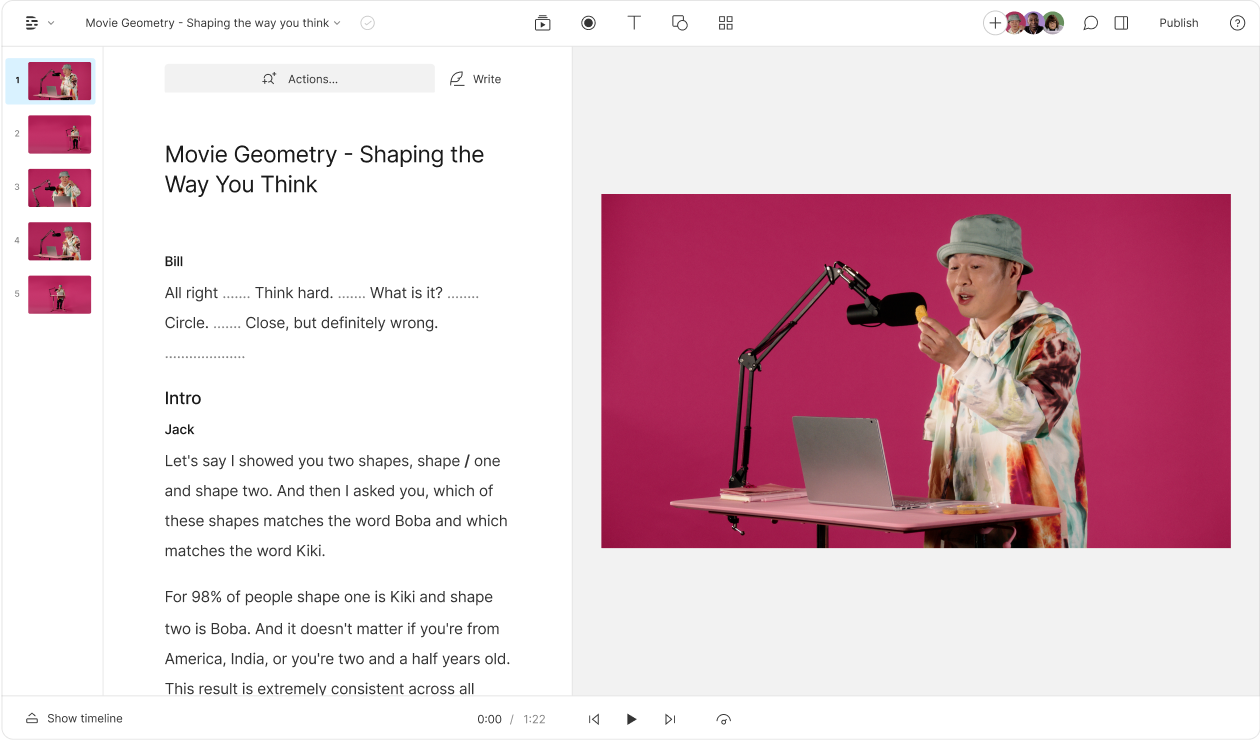What type of content do you primarily create?




We wrote this article with the help of Claude. To do that, we followed the lessons we’re sharing with you now: we gave the chatbot several blog posts and newsletters on which to model its writing, and plenty of direction and detail to ensure it wrote what we wanted it to write. We then edited the article the same way we would any human-written piece.
If you work in marketing, you’ve probably had this experience: You're building a product demo, writing training content, or planning a campaign—and you're making educated guesses about what your audience actually wants. Sometimes those guesses are right. Sometimes they're expensive mistakes.
At Descript, we faced this constantly. Should we prioritize the new layouts feature or focus on better collaboration tools? Would the marketers in our user base prefer more customization options or simpler presets? Without user input, we were basically playing high-stakes guessing games.
The traditional approach meant waiting weeks to schedule research sessions while hoping we could reach the right people and often getting feedback too late to change course. Meanwhile, deadlines kept coming and decisions had to be made.
So I tried something different. I built AI clones of our users.
What I mean by "cloning" users
I know, it sounds like some sci-fi nightmare, but I assure you there were no test tubes involved. Instead, I created custom GPTs—AI agents built with ChatGPT and tailored to my specifications—that simulate realistic conversations with two of our target personas.
I fed ChatGPT everything we knew about our users—interview transcripts, behavioral patterns, workflow frustrations, decision-making criteria. It gave us AI personas that can respond to questions the way our actual users would, complete with authentic attitudes and realistic constraints.
When I ask "Malik" (our B2B marketer persona) about a new feature, he doesn't just say "that looks great!" like generic AI might. He responds with the kind of thoughtful, slightly skeptical feedback you'd actually get from a time-pressed marketing manager who's been burned by overhyped tools before.
The step-by-step process
Building useful persona GPTs isn't as simple as telling ChatGPT to "act like a marketer." Here's how I actually did it:
Step 1: Gather your persona intel
I collected everything we had on our two primary personas—Malik (B2B marketer) and Lindsay (L&D specialist). That included:
- Transcripts from user interviews
- Documented pain points and workflows
- Common objections and concerns
- Behavioral patterns we'd observed
- Specific language they used to describe their challenges
Key insight: you need depth, not just demographic data. Age and job title don't tell you how someone thinks about their workflow frustrations.
Step 2: Create the persona foundation
I built each GPT with specific instructions that covered:
- Professional context and daily pressures
- Communication style and priorities
- Typical workflows and tool frustrations
- Decision-making criteria and risk tolerance
- Language patterns and terminology they actually use.
More importantly, I programmed in different "modes.” Stressed Malik might prioritize time savings while Creative Malik is happy exploring new ideas—just like real people behave differently under different circumstances.
Step 3: Test with questions you know the answers to
This was crucial. I asked questions about scenarios we'd already researched with real users. When the synthetic personas gave responses that aligned with actual user feedback, I knew I was on the right track. When they didn't, I refined the instructions.
Step 4: Iterate based on realistic vs. fantasy responses
The biggest risk with AI personas is getting responses that sound plausible but aren't realistic. I constantly asked myself, "Would a real marketer actually say this?" If the answer was no, I adjusted the context until the responses felt authentic.
Getting colleagues to actually use them
Building the personas was the easy part. Getting people to trust and use them? That took some work.
I started with a simple announcement in our company Slack:
"Meet Malik and Lindsay: Your on-demand user personas are now live in ChatGPT. You need user perspective but can't schedule interviews with every idea. Now you can chat directly with our primary personas anytime."
The reaction was mixed. Some colleagues were immediately intrigued. Others were politely skeptical. A few basically said "that's nice" but clearly didn't plan to try them.
What actually worked was showing specific examples. Instead of explaining what they could do, I demonstrated value:
- I showed how Malik gave different feedback on the same feature when he was in "launch-stressed mode" versus "experimenting mode"
- I walked through how Lindsay identified specific friction points we'd missed in our educational content
- I shared real insights that had already improved our marketing campaigns
The breakthrough came when our product team started using them for quick sanity checks before building features. Our design team began testing concepts with different persona modes. Customer success started anticipating support questions using the personas.
Suddenly, what felt like a marketing experiment became a company-wide tool.
The bigger lesson: Context is everything
Here's what I learned building these personas: AI tools are only as good as the context you give them. This applies to any AI assistant you use, not just persona GPTs.
Most people approach AI with individual queries: "Write me a product description" or "Generate some social media posts." But the real power comes from establishing rich context once, then building on it.
With my persona GPTs, I spent time upfront creating detailed context about user motivations, constraints, and communication patterns. Now every conversation builds on that foundation. The AI doesn't have to guess who it's supposed to be or what priorities to consider—all of that is already established.
This principle applies directly to any AI assistant. Whether you're using Descript's Underlord to edit videos or ChatGPT to write project briefs, better context gets you better results.
What persona GPTs can't do
A quick reality check about the limitations: These persona GPTs are based on patterns from real user research, but they're not perfect predictors of human behavior. They can't capture the emotional nuance of a frustrated user or the spark of genuine insight that comes from live conversation.
They're supplements to real user research, not replacements. When you're making major product decisions or need to validate critical assumptions, you still need to talk to actual humans.
But for the 80% of situations where you need a quick gut check—should we emphasize speed or control in this messaging? Would this onboarding flow confuse new users?—they're incredibly useful.
Think of them as smart sounding boards that help you ask better questions and surface assumptions you might not have noticed.
How to build your own persona GPT
If you want to create persona GPTs for your team, here's my advice:
- Start with research you've already done. Don't try to create personas from scratch. Use existing interview data, support tickets, sales conversations—anything that shows how your users actually think and talk.
- Be specific about context. Instead of "act like a marketer," try "act like a B2B content marketer at a 200-person SaaS company who's responsible for three blog posts per week and constantly dealing with stakeholder feedback on video content."
- Program in realistic constraints. Real users have budget limitations, time pressures, and competing priorities. Make sure your personas reflect these realities.
- Test with known scenarios. Validate that your personas respond authentically to situations you've already researched.
- Create different modes. People behave differently under stress, when they're exploring new ideas, or when they're focused on execution. Build this complexity into your personas.
Better AI skills pay dividends
Working with persona GPTs taught me something unexpected: they make you better at using any AI tool. By learning how to provide rich context and iterate on responses, you develop intuition for how AI assistants work best.
This carries over to everything from writing better prompts for content generation to getting more useful results from AI editing assistants. You start thinking in terms of context, specificity, and iterative refinement rather than hoping for magic on the first try.
It's like learning to ask better questions of any intelligent system—whether that's a colleague, a consultant, or an AI.
The future of work involves collaborating with AI assistants. Building persona GPTs taught me how to make that collaboration more effective. The strange thing is, by teaching AI to act more human, I learned how to work more effectively with AI.
So if you’re still making decisions based on guesswork, maybe it’s time to clone your users, too.
Want to see how AI collaboration works in practice? Try Descript's Underlord, our AI editing assistant that helps you create professional videos through natural conversation. Like the persona GPTs, it works best when you give it good context about what you're trying to achieve.


























%201.svg)
















